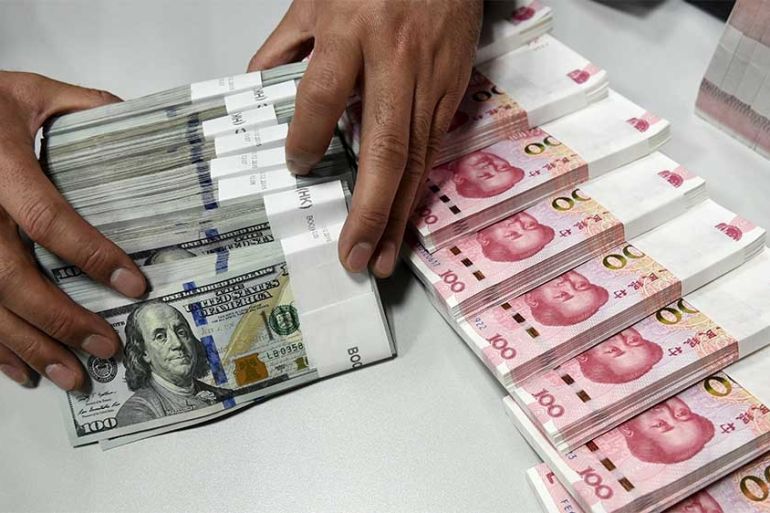US designates China as currency manipulator
US Treasury Secretary Steven Mnuchin will engage with the IMF to eliminate ‘unfair’ competition from Beijing.

The United States government has determined that China is manipulating its currency – and the US will engage with the International Monetary Fund to eliminate “unfair” competition from Beijing, US Treasury Secretary Steven Mnuchin said in a statement on Monday.
The move brings already tense US-Chinese relations to a boil and fulfills US President Donald Trump‘s promise to label China a currency manipulator for the first time since 1994.
Keep reading
list of 4 itemsSix takeaways from first day of Trump’s New York hush money criminal trial
Day 1 of Donald Trump’s first criminal trial
What is Donald Trump’s ‘hush money’ trial all about?
The US action follows a move by China to allow its yuan to weaken past the key seven-yuan-per-dollar level on Monday for the first time in more than a decade.
Beijing said it would stop buying US agricultural products, inflaming a year-long trade war with the US.
The sharp 1.4 percent drop in the yuan comes days after Trump stunned financial markets by vowing to impose 10 percent tariffs on a remaining $300bn of Chinese imports starting September 1 – abruptly breaking a brief ceasefire in a bruising trade war that has disrupted global supply chains and slowed growth.
The news knocked the dollar sharply lower and bolstered the price of gold.
The US Department Department of the Treasury said that a statement from the People’s Bank of China (PBOC) on Monday made clear that Chinese authorities had ample control over the yuan exchange rate.
The PBOC said Monday it would “continue to … take necessary and targeted measures against the positive feedback behaviour that may occur in the foreign exchange market”.
The Treasury statement said, “This is an open acknowledgment by the PBOC that it has extensive experience manipulating its currency and remains prepared to do so on an ongoing basis.”
The statement said China’s actions violate its commitment to refrain from competitive devaluation as part of the Group of 20 industrialized countries. The Treasury said it expected China to adhere to those commitments and not target China’s exchange rate for competitive purposes.
US law sets out three criteria for identifying manipulation among major trading partners: a material global current account surplus, a significant bilateral trade surplus with the US, and persistent one-way intervention in foreign exchange markets.
After determining a country is a manipulator, the Treasury is required to demand special talks aimed at correcting an undervalued currency, with penalties such as exclusion from US government procurement contracts.
The US Treasury had designated Taiwan and South Korea as currency manipulators in 1988, the year that Congress enacted the currency review law. China was the last country to get the designation in 1994.
In May, the Treasury had refrained from declaring China a currency manipulator based on new tougher criteria measuring a country’s global current account surplus, along with persistent one-way intervention and a large bilateral trade surplus with the US.
In the report, however, the Treasury kept China on an enhanced monitoring list due to a “misalignment and undervaluation of the RMB [“renminbi” or money/yuan] relative to the dollar”.